This page contains affiliate links. I’m part of the lululemon collective and will receive a commission if you make a purchase through the links below. As an Amazon Associate, I earn from qualifying purchases. Read the full disclosure here.
Yoga for sciatica pain relief is one of the most widely searched practices, and for good reason. Everyone wants to know easy ways to heal their sciatic pain.
Even in yoga teachers’ Facebook groups, the “best poses for sciatica” is practically a daily question.
Unfortunately, the responses are usually pigeon pose, followed by more hip openers, complete with plenty of people dolling out incorrect medical advice with no credentials.
As a physical therapist and certified yoga teacher, I’m going to say let’s just stop right there.
I hear you, sciatica can cause severe pain, and you’re trying to be proactive and learn any stretch that might grab some pain relief.
Can yoga make sciatica worse?
Actually, it can. But that’s because not all sciatic pain is the same, and there’s a plethora of misinformation circulating.
So before we go blindly recommending poses to “fix” sciatica, I’ll give you some background information to help you confidently tease out which yoga poses to avoid with sciatica.
Disclaimer: This content is for educational purposes and is not medical advice. Read the full disclaimer.
What is sciatica?
First of all, let’s back up for a second and clarify what sciatica is.
Most cases are a result of irritation to the sciatic nerve originating in the lower back.
Unfortunately, sciatica ends up being a catch-all term that people use to describe any pain in the low back and hip radiating down the back of the leg.
Here’s the problem.
It may surprise you to learn that sciatica itself is not a diagnosis. It’s a symptom (with several possible causes).
Sciatic nerve pain may accompany lower back pain, or it may be present on its own.
Here are some potential ways this tissue can become angry to illustrate the many causes of sciatica.
- Lumbar disc bulge or herniation (slipped disc)
- Impingement at the lumbar nerve root
- Muscular spasm
- SI joint (sacroiliac joint) issues
- Piriformis syndrome
- Pregnancy
- Spinal stenosis
- Degenerative disc disease
- Spondylolisthesis
- Arthritis
- Osteoporosis
- Limited hip mobility
- Trauma
- Malignancies or infections
Conditions such as vascular disease or peripheral neuropathy can mimic sciatic symptoms but are very different conditions.
Hamstring strains can also be mistaken for sciatic nerve pain, but a proper evaluation will tell them apart.
Each of these conditions has its own set of dos and don’ts.
Calling something sciatica isn’t very specific, and there isn’t one magical set of exercises that will fix sciatica.
Most cases of sciatica are a result of irritation to the sciatic nerve originating at the lower spine (lumbar spine). However, people are quick to call pain in the back of the leg “sciatica,” whether it is or not.
The term is used fairly inconsistently by health professionals and fitness professionals alike, leading to confusion and an abundance of misinformation circulating.
If you’re googling “yoga poses for sciatica,” you’re asking the wrong question. Instead, the answers lie in what’s causing your sciatic pain.
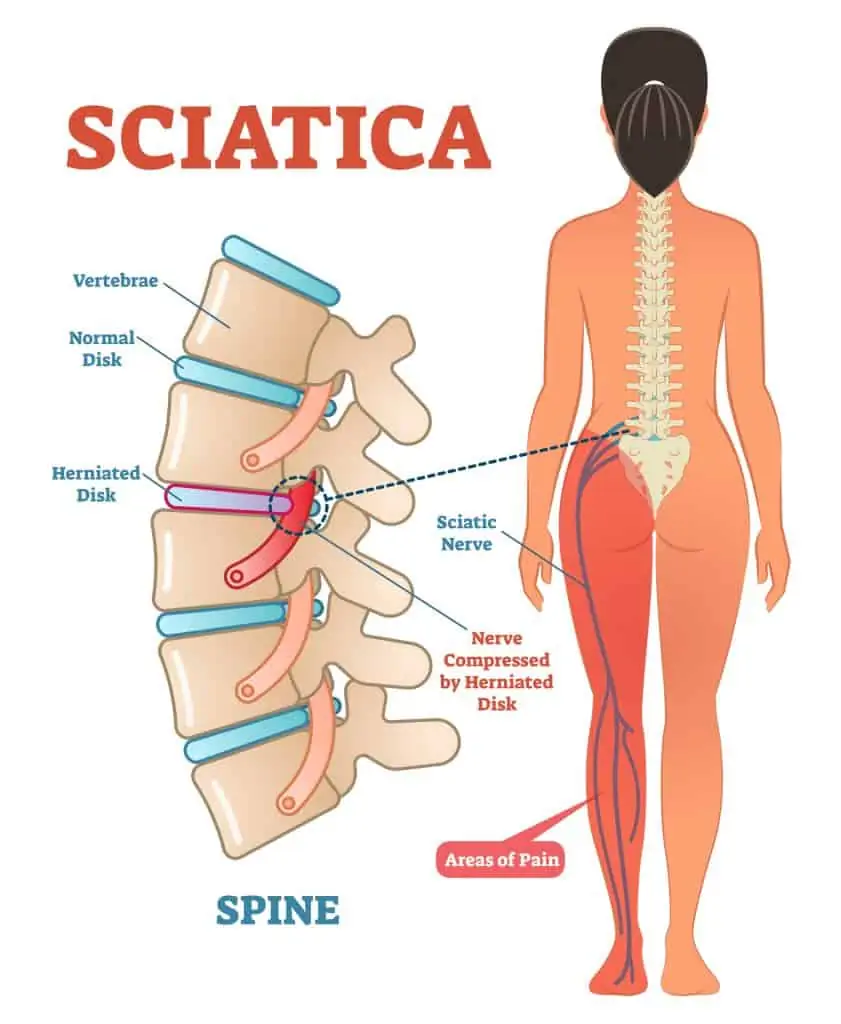
Why “yoga for sciatica” is incomplete
Dumping all of these leg pain causes into a big garbage can labeled “sciatica” gets confusing in a hurry. Before you set out in search of that magical yoga stretch, let’s clarify a few points.
We’ll go back to the example of pigeon pose – a pose that the yoga world tends to recommend as a “cure-all” for sciatica blindly.
Pigeon pose is a deep hip external rotation stretch.
If pigeon pose feels good to you, that’s great, but it doesn’t feel good for everyone, and it shouldn’t be promoted as a cure or fix.
Here’s why.
If sciatica results from a lumbar disc bulge, pigeon pose may not increase your symptoms but won’t do much to heal the disc herniation.
Forward folds and hamstring stretches (including downward facing dog) are likely to aggravate the sciatic nerve. Extension exercises, such as cobra pose or sphinx, tend to be helpful for lumbar disc bulges.
If sciatica results from muscle tension in the back of the hips (a popular example is the piriformis muscle), then pigeon pose might feel great and even relieving for some time.
But if the pain keeps returning, you have to ask yourself what else is going on that’s causing the muscles to spasm constantly. There’s likely an issue somewhere else causing compensation, preventing sciatica relief.
If the pain is due to an SI joint issue (sacroiliac joint), pigeon pose might make you feel worse by placing aggressive pressure on an already painful joint.
Remember, these are just general examples. I’m not telling you how to treat your pain.
The point being, you need to get evaluated to determine your cause of sciatica.
Then you can start to tease out what movements and yoga asanas to encourage and what to avoid.
Also, sciatica sufferers beware of any yoga pose or practice that claims to “fix” your sciatica.
This is inappropriate wording, and yoga teachers are not trained (nor allowed) to diagnose and prescribe exercises to “fix” your conditions.
Yoga teachers can provide modification options to work around your conditions and make poses more comfortable for you.
If your yoga teacher also happens to be a medical professional, you’d need to see them in a professional medical setting for an evaluation and specific advice.
Yoga can be an excellent complementary activity, but you should really know what you’re dealing with and seek the proper treatment.
You can help heal your sciatica by understanding your sciatic pain and associated movements to avoid.
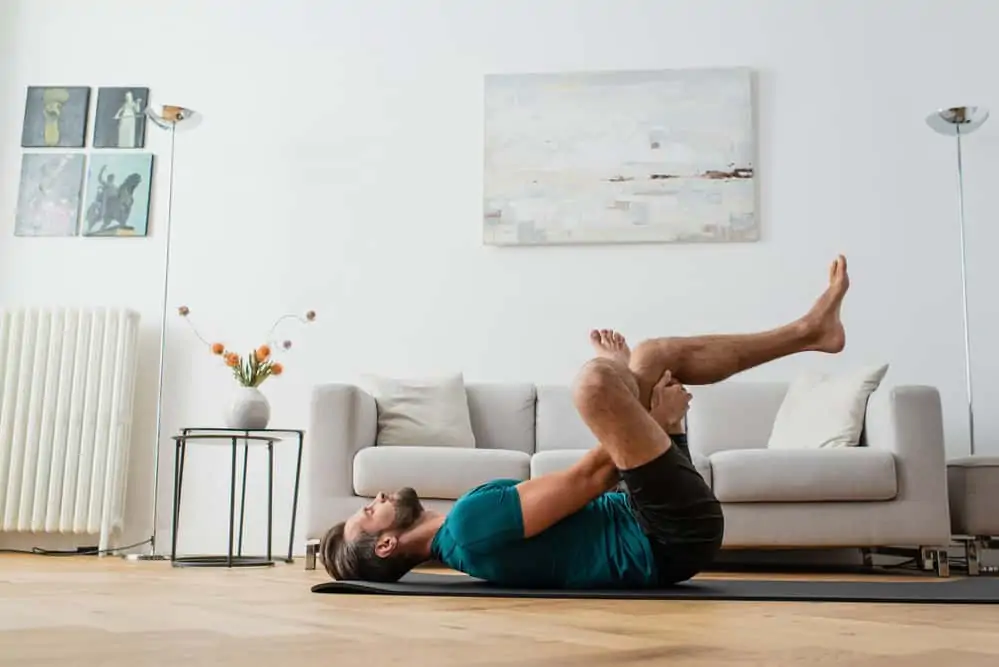
Yoga poses to avoid with sciatica
Getting evaluated to determine the cause of your pain as well as movements to encourage and avoid is the first step to tailoring your yoga practice to work for you.
Make sure that your healthcare provider understands the type of yoga that you do and the movements required.
To a healthcare provider who isn’t familiar with yoga, it’s often viewed as a very gentle exercise. Depending on your practice, this may or may not be the case. Even gentle yoga can aggravate sciatic pain in the wrong positions for you.
Specifically, ask about movements to avoid and movements to encourage (for example spinal flexion, spinal extension, rotation, hip mobility, etc.) Physical therapy is a good resource to help you understand various movements to avoid.
You can demonstrate poses or show pictures/videos to help your provider understand the movements you’d like to do. The more they know, the more they can guide you.
If you’re not familiar with which poses align with each movement, take that information to your yoga teacher to ask which poses to modify/avoid.
There’s always a way to modify or choose variations or substitute poses with the same goals in mind.
Here are some poses, in general, to be cautious with on your road to recovery.
(This is by no means a complete list, but just some common conditions/poses that tend to be culprits for sciatic pain.)
Forward bends
Forward bends or any pose that has a heavy hamstring component or posterior chain stretch can tug at the sciatic nerve and cause additional pain.
Lumbar flexion also tends to aggravate lumbar disc herniations, a major cause of sciatic pain.
Caution with:
Related read: Activities & Exercises To Avoid With A Lumbar Herniated Disc
Extreme motions in any direction
Especially if sciatic pain is a result of SI joint issues, extreme forward bends, extreme spinal extension, twists, or even hip stretches have the potential to aggravate symptoms.
Utilize props such as blocks, blankets, straps, or chairs to support your body and shorten the distance to place less strain on injured tissues.
For SI joint issues, caution with hip opening poses like:
For ideas on how to use yoga blocks for injury prevention, read this article.
Excessive spinal extension
Extension may feel great for a lumbar herniated disc but can aggravate other conditions like spinal stenosis or SI joint issues.
Caution with:
- Cobra
- Upward facing dog
- Wheel
- Rapidly moving from a very flexed position to an extreme extension position (and vice versa)
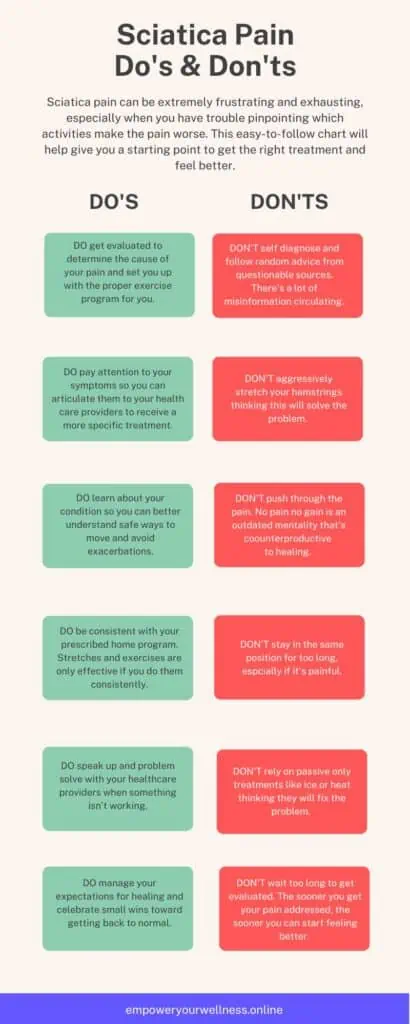
FAQ about yoga for sciatica
In this section, I answer some of the most commonly asked questions on Google about yoga for sciatica.
Can sciatica be cured by yoga?
Cured is a big word.
Do people get lucky and have a stretch or two “cure” some fleeting sciatic pain? Probably.
I suppose anything is possible by accident. But in reality, you really need to find out the cause of your sciatica and have appropriate medical treatment that’s targeted to your cause of sciatica.
Remember, sciatica is a symptom and several things can cause (or mimic) symptoms.
Yoga is a wonderful complimentary activity as long as you understand what movements to avoid making your symptoms worse.
What type of yoga is best for sciatica?
Slower moving practices give you time to move and adjust to a pose. Using props such as blocks or staps easily makes poses more accessible without aggravating symptoms.
Styles such as Hatha, slow vinyasa, Iyengar style, restorative, or certain yin poses may be appropriate. Keep in mind that within each of these styles, there will be poses that aggravate symptoms so it’s essential to know which movements to avoid.
Avoid fast-paced classes, classes that promote extreme movements or the “fullest expression of the pose” and styles that quickly move the spine between flexion and extension.
Certain yin yoga poses, especially ones that hold flexion of the spine for long periods of time can be aggravating to sciatica.
What positions relieve sciatic pain?
Relieving poses are entirely specific to what is causing your sciatic pain. There is no one magical set of exercises that works for everyone.
The best way to determine poses and positions that will work for you to get an evaluation by a physical therapist.
Is yoga or Pilates better for sciatica?
One isn’t necessarily better than the other, but the two practices have different goals.
Pilates has a heavy focus on core and postural muscle strengthening. These exercises can be beneficial when recovering from sciatica, however, Pilates features a lot of exercises that are performed in spinal flexion and this may aggravate sciatic symptoms.
Be sure to understand which movements to avoid and ask for modifications to not aggravate existing problems.
Related read: Is Pilates Safe For Osteoporosis
Is downward dog good for sciatica?
Downward dog can either be aggravating or relieving, depending on the variations taken.
When performed with a flat or rounded back and straight legs, this can aggravate the sciatic nerve, creating tension and pain.
Try keeping a neutral spine and hinging from the hips, but allow the knees to bend deeply. This takes some of the tension away from the nerve path.
Other great variations to enjoy this stretch include placing blocks underneath your hands or doing more of a standing variation holding on to a chair.
Can yoga make sciatica worse?
Many people turn to yoga for sciatic relief, but the truth is if you’re not listening to your body or fail to understand the root cause of your sciatica pain, yes, yoga can make sciatica worse.
The best thing you can do is get evaluated to determine the root cause of your pain and then work with your health care providers and yoga teachers to determine which yoga poses to avoid with sciatica as you heal.
After your pain is completely resolved, it may be safe to begin to work your way back to a full practice again.
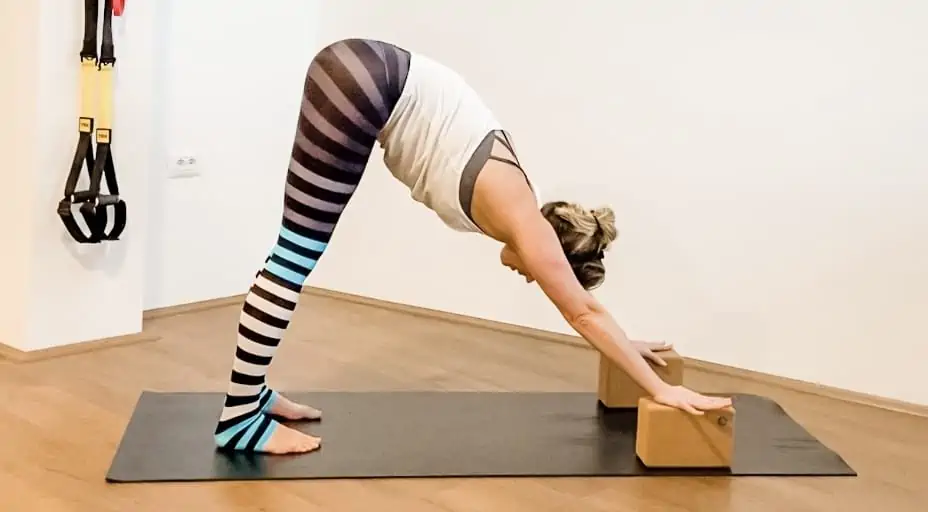
Building your version of yoga for sciatic pain
Make your yoga practice work for you by understanding what yoga poses to avoid with sciatica.
This breakdown will help guide you toward the proper steps to protect yourself and take an active role in your health.
If you’d like to keep reading, check out What To Avoid When You Have Sciatica for more expert tips to get you one step closer to pain relief.
Remember, don’t blindly give advice about sciatica because not all sciatica is the same. Your “best yoga pose” for sciatica may be completely different.

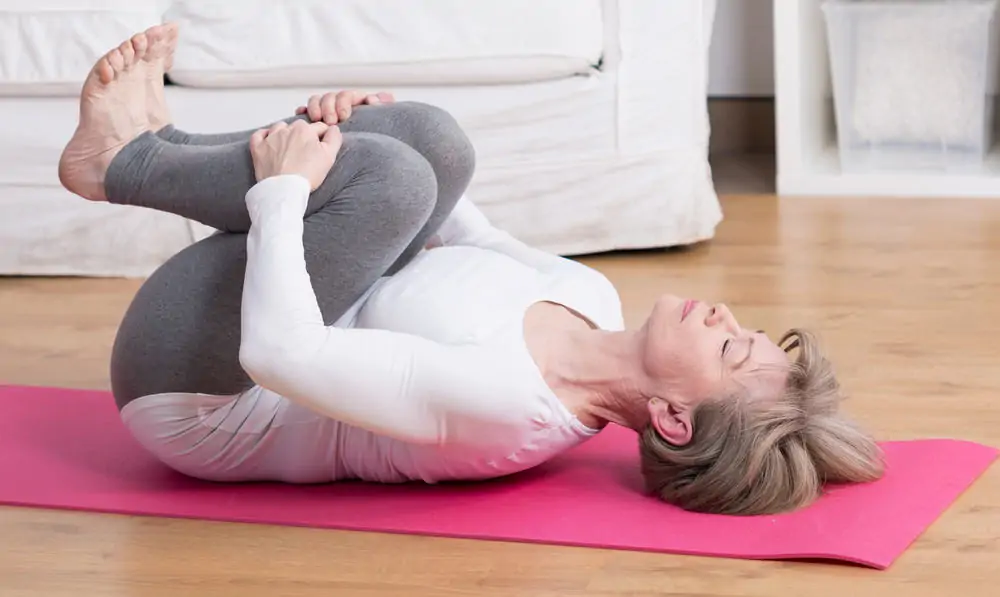
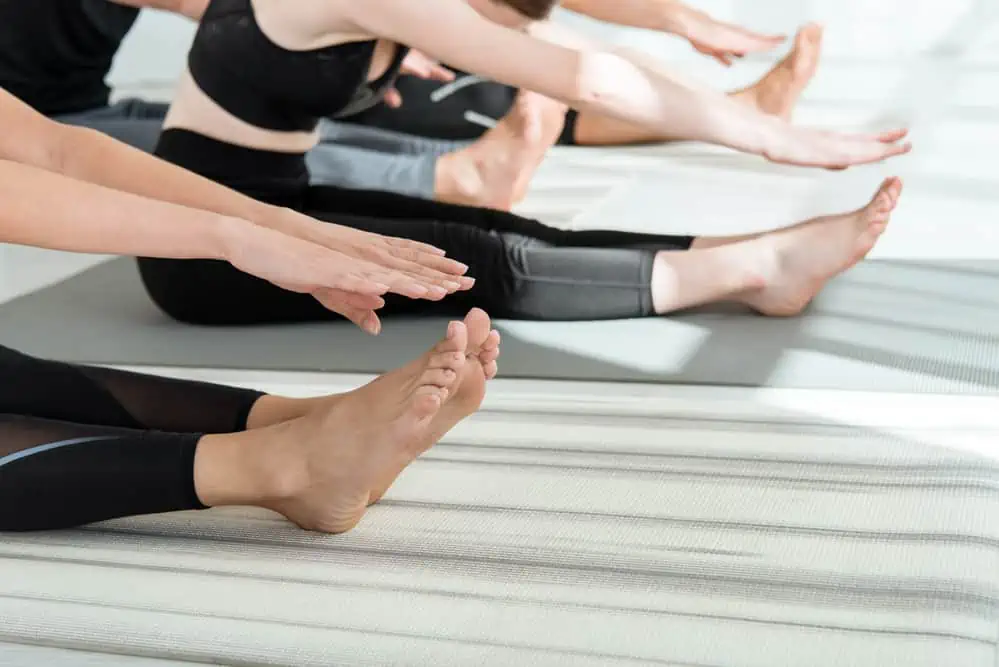
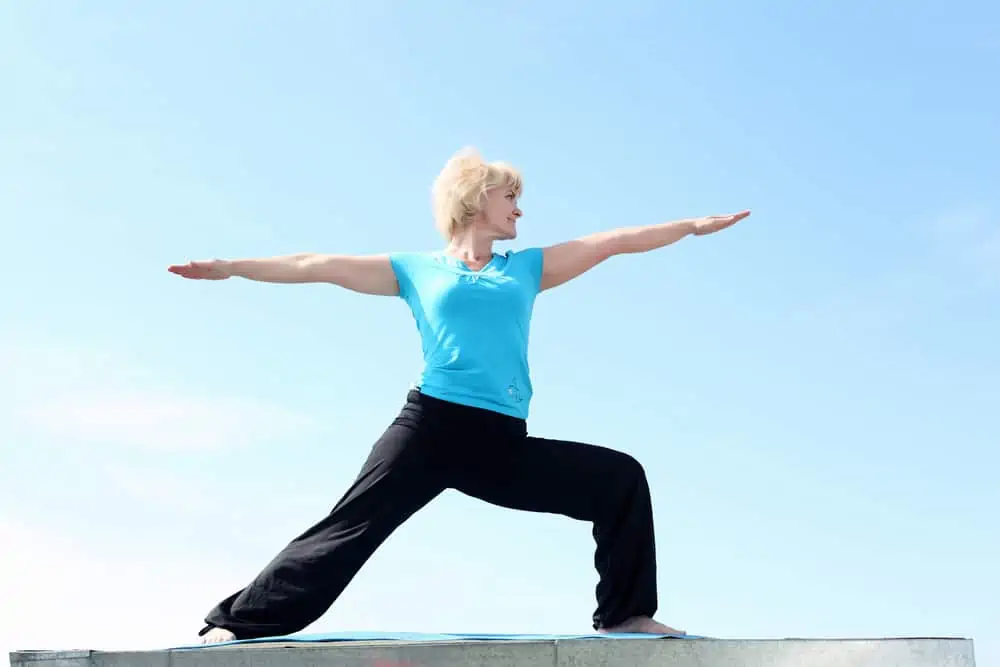

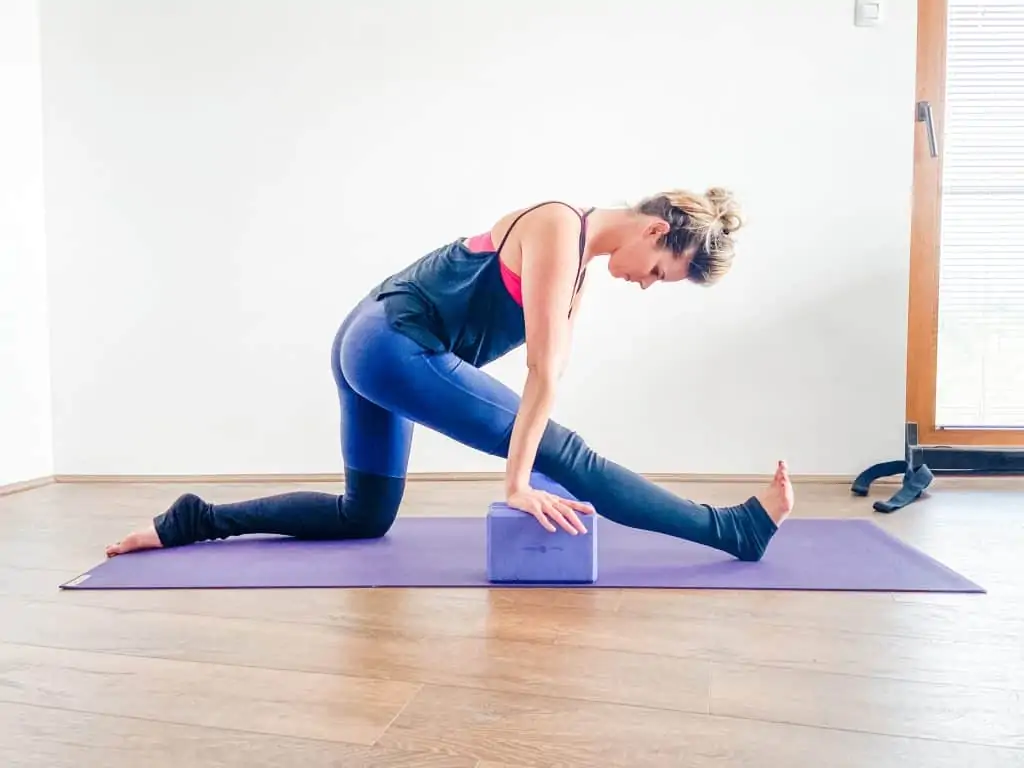


I used to struggle with sciatica SO BADLY. It’s not as bad now, but this will be SO helpful!
This is so helpful! I will have off and on pain in this area and knowing specific yoga poses to help will make a big difference! Thanks for sharing!
Great advice! As someone who does yoga on a regular basis, I’ve definitely experienced it can be both beneficial and can also make things worse if not done carefully. Still my favourite way to stay fit 🙂